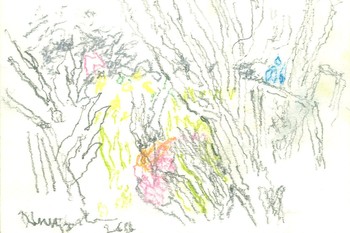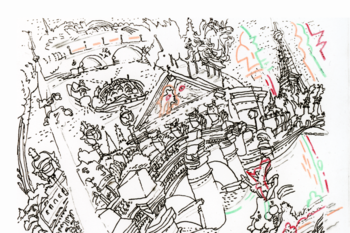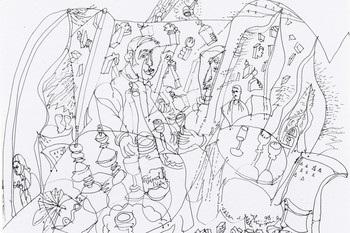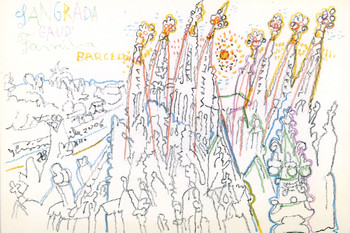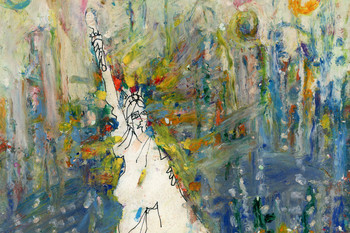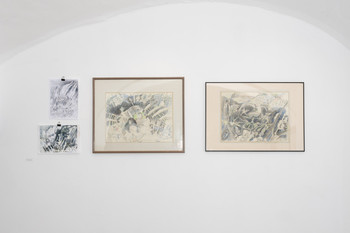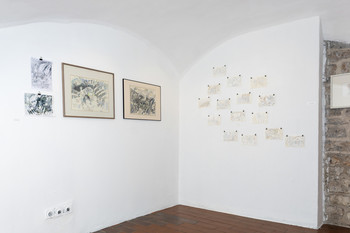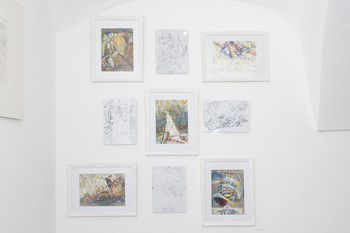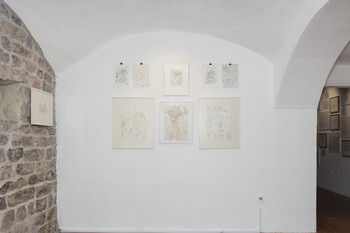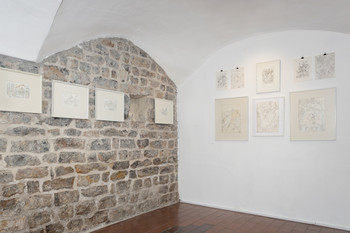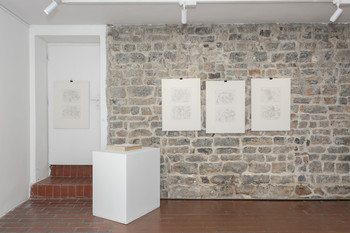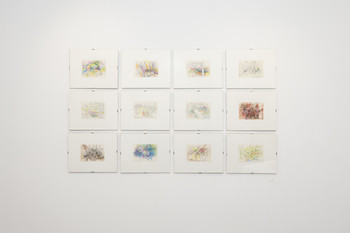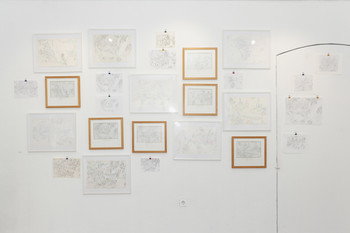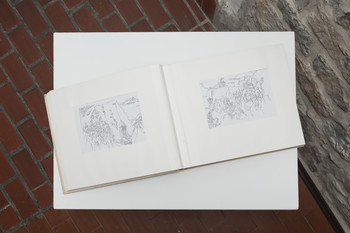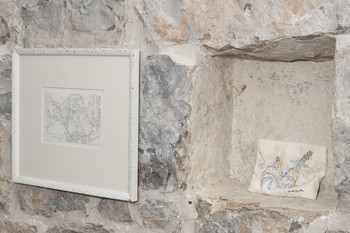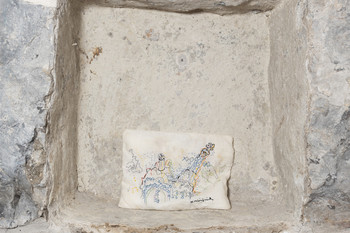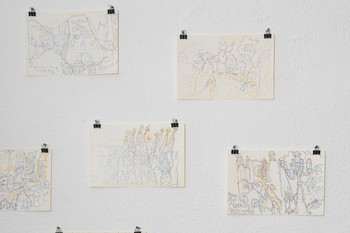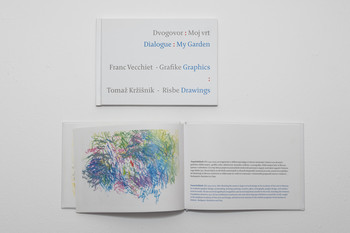Time Captured in the Drawings by Tomaž Kržišnik
29 Jan – 23 Mar 2025
Ivan Grohar Gallery
Curators: Anabel Černohorski, Maja Kržišnik
The exhibition of drawings by the versatile artist Tomaž Kržišnik at the Ivan Grohar Gallery includes selected series from Krakow, Paris, Barcelona and New York City. Each of the series highlights Kržišnik’s diverse approaches to the medium of drawing. The exhibition features original drawings in various formats, Xerox copies (with drawing elements added by the artist) and drawings collected in a special album. Also on view is Kržišnik’s last series of drawings titled My Garden, created as part of the Kržišnik Gallery’s Dialogues project in 2022.
The visual artist Tomaž Kržišnik (9 February 1943 – 22 May 2023, Žiri) was active in a wide range of creative fields, including the design of books, posters, sets, puppets and interiors; he worked on the glass and ceramics design of numerous public and private spaces. As a graphic designer, he created a logo for the Alpina brand, among others. Throughout his artistic career, he was also active as a painter, printmaker and drawing artist. The designer and professor Radovan Jenko wrote the following about Kržišnik’s work in the In Memoriam notice published on the website of the Academy of Fine Arts and Design in Ljubljana, where Kržišnik had lectured in visual communication for many years: “When it came to graphic design, he was a drawing artist/painter, and when it came to drawing/painting, he was a designer.”[1] Kržišnik approached a particular medium in an innovative way, effortlessly combining techniques and methods from different disciplines and media to achieve his goal.
The exhibition presents only a part of Kržišnik’s extensive drawing oeuvre, created and exhibited from the 1970s onwards. The first gallery room houses the 1998 series titled Krakow, which comprises drawings in various formats, made with coloured ballpoint pens, Xerox copies, mixed media works and an album. On view next to the Krakow series is a 2022 series of small-format colour pastels titled My Garden. The last gallery room features drawings in various formats, created during Kržišnik’s trips to Paris in 1986 (ink and coloured pencils, etching, Xerox, mixed media) and the USA in 1999 (coloured pastels, Xerox), as well as during his visits to Barcelona in 1989 and later, i.e. in 2006 and 2007 (ink and coloured pencils, Xerox, mixed media).
The artist’s last series, My Garden, was created as part of the project titled Dialogues, conceived by Maja Kržišnik. In 2022, she invited a number of artists who had walked part of their respective lives and creative paths together with Kržišnik to take part in an exhibition. Collaboration with the Trieste-based painter and printmaker Franc Vecchiet was special because the artist duo decided that their joint exhibition would not feature any past works, choosing to create brand new works for this very purpose instead. Both artists found inspiration for the works in their home garden. The result is a series of almost abstract depictions of Kržišnik’s garden in Žiri, which are exhibited in the first gallery room. The garden is a veritable botanical treasure, designed in the late 1970s by Juta Krulc, a pioneer of garden design. This is the first time that Kržišnik’s series is on view since the premiere exhibition. A catalogue published at the time of Kržišnik and Vecchiet’s joint exhibition (15 September – 5 October 2023, Kržišnik Garden and Gallery, Žiri) is also on display.
One of the series presented in the first gallery room is Krakow (1998), which features all the characteristics of Kržišnik’s travel drawings, i.e. they depict the town’s architecture and people. This was the artist’s way of capturing everything that surrounded him at a given moment. Often, he used a single sheet of paper to depict several different things that he observed going on, which sometimes makes the whole feel like a comic book narrative, but without the linearity of a time sequence; it looks like a collage of several simultaneous moments. In addition to the artist’s signature, the drawings often contain information about the year and place of creation.
The new technical possibilities afforded by photocopier had fascinated Kržišnik from the very beginning. He soon started creating Xerox copies of his own works, which he then worked on further, cut or added to. He was thus able to scale down or otherwise alter the original formats. Sometimes, he hand-coloured black-and-white Xerox copies of his travel drawings with coloured pencils or pastels, creating new final works. Some of the exhibited drawings are therefore repeated, i.e. they come in slightly different duplicates. Kržišnik sometimes exhibited two, three or more copies on a single display board, or each copy in its own frame, like the original drawings. The Krakow series, however, contains the only example of Kržišnik using drawings scaled down by means of a Xerox and inserting them in an album, as if they were travel photos.
The second gallery room features The Parisian Series, America with drawings of New York City and Barcelona, with scenes depicting lively cafés and street life from these cities, much like the Krakow series. One of the most noteworthy and eye-catching works is a large-format drawing of a train journey from Ljubljana to Paris that the artist and his family made in 1986. The journey itself is part of travelling, so the fact that Kržišnik’s depictions include moments in motion is not at all unusual. In fact, the rest of the artist’s oeuvre includes several depictions of ship’s deck views and airplane window views.
Kržišnik’s drawings are full of familiar architectural and other cultural landmarks. Two such landmarks that stand out among the exhibited works are NYC’s Guggenheim Museum with its characteristic spiral shape, both in black and white and in a very colourful interpretation, as well as a large-format depiction of the Pompidou Centre in Paris, which the artist cut with scissors and added drawings to the empty fields. The depictions of Gaudí’s architecture in Barcelona testify to Kržišnik’s skill in adding dynamic quality to static monuments.
Much of Kržišnik’s drawing oeuvre was created “en route”, i.e. at various artist residencies, art colonies and art-related trips, as well as during family trips, both in Slovenia and abroad, where he usually had a brand new sketchbook and pencils at hand. The artist’s last series, created at his home in Žiri between 2 and 17 June 2022, marks the end of another journey, a journey called life. For this reason, it has been placed at the very beginning of the exhibition, which is also the end, viewed right before visitors leave the exhibition venue.
Time Captured in the Drawings by Tomaž Kržišnik refers to specific moments in the artist’s life, serving as a kind of diary entries. However, in his drawings, the artist also captured a less noticeable time, one that encompasses the artistic and mechanical processes, i.e. the process of creating a particular work of art. Among other things, the exhibition raises the question of reproductions and originals, and the particular alliance between the two categories. As part of Kržišnik’s distinctly contemporary approach, which defies the purity of the medium in order to achieve the artist’s vision, the original drawing often becomes a mere foundation for the final work.
Tomaž Kržišnik
After finishing the Secondary School of Design in 1962, Tomaž Kržišnik (1943–2023, Žiri) enrolled in the College of Education in Ljubljana. In 1964, he started his studies at the Academy of Fine Arts in Warsaw, where he graduated with a Master’s Degree in Book Illustration in 1968. After returning to Ljubljana, he first taught graphic design at the Secondary School of Design (from 1973 to 1976) and then obtained the freelance artist status. Between 1988 and 2008, he lectured in visual communication at the Academy of Fine Arts and Design in Ljubljana.
He received the Prešeren Fund Award for the designs he created for the puppet show The Golden Bird (1975), the International Jury Award at the International Biennial of Graphic Arts in Ljubljana (1983) and the 1989 Plečnik Award (together with Andrej Kemer and Miljenko Licul). In 2013, he won the Grohar Award by the Škofja Loka Artists’ Association and was named an Honorary Citizen of the Municipality of Žiri. In 2023, the Slovenian Independent Illustrators’ Biennial awarded the first Tomaž Kržišnik Recognition Award, named after him. In 2024, he was posthumously awarded the Smrekar Lifetime Achievement Award at the 15th Slovenian Biennial of Illustration.
[1] Jenko, Radovan, Tomaž Kržišnik: IN MEMÓRIAM, ALUO UL, 2023, accessible on: https://www.aluo.uni-lj.si/objava/in-memoriam-tomaz-krzisnik/
